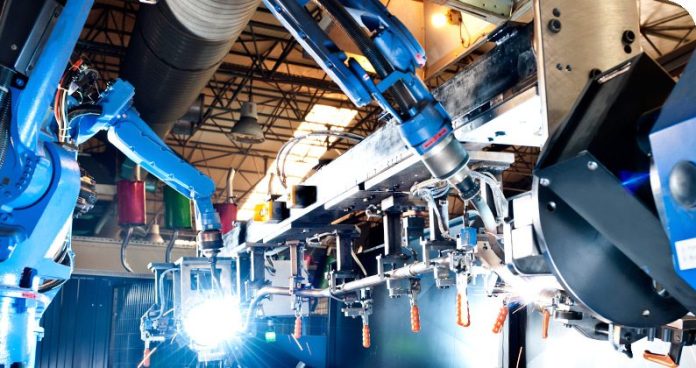Manufacturing is a key growth area for the internet of things
The internet of things is driving digital transformation in a variety of industries looking to embrace connectivity to increase process efficiencies that cut costs and create new revenue streams. Smart manufacturing–the digitalization of supply chain and factory floor operations–is a key growth area for the booming IoT. Here we take a look at how smart manufacturing has created new value for Intel and Bosch Rexroth, and hear from industry consortium Manufacturing Enterprise Solutions Association (MESA) International about best practices for stakeholders looking to leverage IoT solutions.
Intel’s digital transformation
In a Q&A with Steve Chadwick, Intel Principal Engineer of Manufacturing IT, he discussed turning data into actionable insight for an always-on operation. “Intel’s manufacturing process runs 24 hours a day, 7 days a week, 365 days a year,” Chadwick said. “Running a factory non-stop requires considerable investment in our equipment. By utilizing the sensors in the tools, we are able to maximize the equipment availability and utilization. We have been able to create a data visualization tool that presents factory engineers with graphs that distinguish critical errors from noncritical errors and show where manufacturing equipment is running well and where opportunities exist to improve efficiency. This focuses attention on the most meaningful improvements to increase equipment availability and yield.”
He continued: “Our goal is to consume this data and turn it into insights. Leveraging these sensors is not new, but the data volume that is generated has been rapidly growing. For example, we have used advanced analytics to process more than five billion data points per day per factory, which enables engineers to extract needed information in 30 seconds instead of four hours. Now engineers can focus on solving problems and designing solutions instead of extracting data. What is new, is the ability to utilize our IoT technology to drop a sensor anywhere it’s needed. This makes monitoring locations that were previously difficult to reach, within grasp. This alone has opened additional vectors of data that can be turned into information previously un-accessible.”
Bosch Rexroth uses RFID tags to manage multi-product line production
In a Q&A with Manfred Hahn, VP and Technical Plant Manager, Bosch Rexroth, discussed gaining data and visibility with radio frequency identification (RFID) tags in an environment where multiple product types are assembled on shared product lines–a situation that requires “an extraordinary combination of productivity and versatility.
“A production information system continually collects, filters and displays production data, immediately informing operators and managers about the status of the line. The individual workstations on the line read Bluetooth tags to identify the user and adapt the workplace to their skills and preferences. Assembly instructions for the product being worked on are beamed with a light guided system (LGS) or displayed on the screen with a level of detail that depends on the worker’s level of experience.”
RFID tags allows torque drivers to automatically load the correct production tool thereby “enabling operators to focus on other tasks,” Hahn explained. “The RFID tag communicates with each individual station, including material requests and assembly operations required for the product in the fixture. Some of these operations, such as torque driving operation are performed automatically. The central workstation where the valves are tightened have three different screwdrivers and is supplied with valves from two sides. The torque drivers move into a position on a gantry and can be equipped with a different screwdriver in seconds.
“The RFID tags of the products moving down the line are monitored by the production control system to trigger replenishment of components when needed. Automatic guided vehicles (AGV) are loaded with parts at a central loading station. Here, the parts required to fulfill each order are loaded onto carts and delivered by the AGV to the multi-product line shortly before they are scheduled to be built.”
MESA International: Smart manufacturing can create ‘transformational value’
Mike Yost, president of the nonprofit Manufacturing Enterprise Solutions Association (MESA) International, and Conrad Leiva, chairman of MESA International’s Smart Manufacturing Working Group, shared their perspective on opportunities for digitalization and the IIoT in the manufacturing sector during a recent interview with Enterprise IoT Insights.
In smart manufacturing, you should start by identifying the problem you want to solve and the desired business outcome before evaluation technology stacks. Yost said there’s no one-size-fits-all solution. “Everybody does it their own way and that’s a challenge. I think the biggest learning that we’ve had over the past couple of years has been not to chase technology but focus on the problems you’re trying to solve. How are you trying to innovate? How are you trying to beat or outflank your competitors? Then figure out what tech stack you need.”
Yost said, in the past, manufacturers have taken something of a piecemeal approach, buying standalone systems and trying to integrate those with legacy assets. “You’re left with a lot of gaps that end up getting filled with custom code or a bunch of different solutions plugged together. We’ve had a really disjointed, fragmented approach over the years. It doesn’t have to be that type of approach any longer.”
Beyond the technological aspect of smart manufacturing, Yost and Leiva both commented on the need for an educated workforce that’s prepared to buy and use these solutions.
“This is a journey and an evolution,” Leiva said. “There are skills that people need jumping into it midway versus the skills that you’re going to need at the end of the journey. And are you one of the people that are needed to put this infrastructure in place, to set up and configure all the equipment in the plants, or are you going to be the one that’s running the equipment and maintaining the equipment?” He noted the industry is “dying for these things to get connected quickly,” but predicted a long process.

